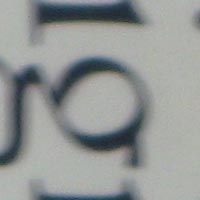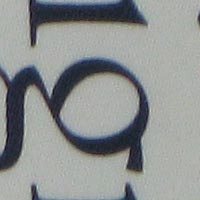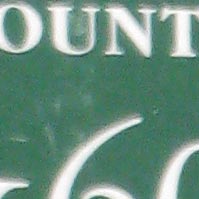Canon Powershot G9 Review
Review Date: October 8th 2007
Author: Mark Goldstein
Leave a comment about this Review
|
Image Quality
All of the sample images in this Review were taken using the 12.1 megapixel SuperFine JPEG setting, which gives an average image size of around 6Mb.
Noise
There are 6 ISO settings available on the Canon Powershot G9 which you can select at any time if the camera is in any of the creative shooting modes. Disappointingly, but not unsurprisingly, image noise is readily visible in images taken above ISO 200, leading me for the most part to steer well clear of ISO 800 and 1600 (or ISO 3200 selectable via the scene modes, unless you're aiming for a homage to the Impressionists). Here are some 100% crops which show the noise levels for each ISO setting.
ISO 80 (100% Crop) |
ISO 100 (100% Crop) |
 |
 |
ISO 200 (100% Crop) |
ISO 400 (100% Crop) |
 |
 |
ISO 800 (100% Crop) |
ISO 1600 (100% Crop) |
 |
 |
Sharpening
Here are two 100% crops which have been Saved as Web - Quality 50 in Photoshop. The right-hand image has had some sharpening applied in Photoshop. The out-of-the camera images are a little soft at the default setting ideally and benefit from some further sharpening in a program like Adobe Photoshop. You can also change the in-camera sharpening level to suit your tastes via the My Colors menu option.
Original
(100% Crop)
|
Sharpened (100% Crop) |
 |
 |
 |
 |
File Quality
The Canon Powershot G9 has 3 different JPEG image quality settings available, with Superfine being the highest quality JPEG option. Here are some 100% crops which show the quality of the various options, with the file size shown in brackets.
|
12M
Superfine (5.44Mb) (100% Crop)
|
12M
Fine (3.33Mb) (100% Crop)
|
 |
 |
|
12M
Normal (1.60Mb) (100% Crop)
|
|
 |
|
RAW Format
The Canon Powershot G9 supports both JPEG and RAW format files. Here are some RAW images for you to download and evaluate.
Download
Example #1
Download
Example #2
Download
Example #3
Chromatic Aberrations
The Canon Powershot G9 handled chromatic aberrations excellently during the review. There's very slight fringing between areas of high contrast – bright skies and foreground for example – but it's only noticeable on really close inspection, as shown in the examples below.
|
Example
1 (100% Crop)
|
Example
2 (100% Crop)
|
 |
 |
Macro
The Canon Powershot G9 offers a Macro setting that allows you to focus on a subject that is just 1cm away from the camera when the lens is set to wide-angle. The first image shows how close you can get to the subject (in this case a compact flash card). The second image is a 100% crop.
|
Macro Shot |
100% Crop |
 |
 |
Flash
The flash settings on the Canon Powershot G9 are Auto, Manual Flash On / Off, Slow Sync Speed and Red-eye Reduction. These shots of a white coloured wall were taken at a distance of 1.5m.
|
Flash Off - Wide Angle (35mm) |
Auto Flash - Wide Angle (35mm) |
 |
 |
|
Flash Off - Telephoto (210mm) |
Auto Flash - Telephoto (210mm) |
 |
 |
And here are some portrait shots. Both the Auto setting and the Red-eye reduction modes caused a very small amount of red-eye.
|
Auto |
Auto (100% Crop) |
 |
 |
|
Red-eye reduction |
Red-eye reduction (100% Crop) |
 |
 |
Night Shot
The Canon Powershot G9's maximum shutter speed is 15 seconds, which is great for night photography. The shot below was taken using a shutter speed of 1/2 second, f/3.2 at ISO 400. I've included a 100% crop of the image to show what the quality is like.
|
Night Shot |
Night Shot (100% Crop) |
 |
 |
Anti Shake
The Canon Powershot G9 has an anti-shake mechanism, which allows you to take sharp photos at slower shutter speeds than other digital cameras. To test this, I took 2 handheld shots of the same subject with the ISO speed set to 100. The first shot was taken with anti shake turned off, the second with it turned on. Here is a 100% crop of the image to show the results. As you can see, with anti shake turned on, the images are much sharper than with anti shake turned off. This feature really does seem to make a difference and could mean capturing a successful, sharp shot or missing the opportunity altogether.
| Shutter Speed / Focal Length |
Anti Shake Off (100% crop) |
Anti Shake On (100% crop) |
| 1/30th sec / 210mm |
 |
 |
| 0.5 sec / 210mm |  |
 |
Overall Image Quality
As you'd expect from such an enthusiast's model, images appear sharp, well exposed and crystal clear on the Canon Powershot G9's large 3 inch screen – and happily the same is true once downloaded to the desktop and examined in closer detail. There's no doubting that optical image stabilization is a real plus at the longer end of the zoom, meaning that any blurred images among the test shots were few and far between. The degree of highlight and shadow detail is also acceptable at this level. Disappointingly, but not unsurprisingly for a 12 megapixel camera, image noise is readily visible in images taken above ISO 200, leading me for the most part to steer well clear of ISO 800 and 1600 (or ISO 3200 selectable via the scene modes, unless you're aiming for a homage to the Impressionists). The built-in flash worked well indoors, with no red-eye and good overall exposure, although the lens exhibits noticeable vignetting at the wide-angle focal lengths. Macro performance is amazing, allowing you to focus as close as just 1cm away from the subject and capturing lots of detail. The Canon Powershot G9's maximum shutter speed is 15 seconds, which is great for night photography, and the quality of the after-dark images is excellent. Left on default, under daylight, the Canon G9's colours are vivid enough for my tastes, with reds, greens and blues nicely 'punchy'. Skin tones are warm and flatteringly healthy without being unrealistically so. There's some very slight fringing between areas of high contrast – bright skies and foreground for example – but it's only noticeable on really close inspection, and certainly not on an A3 print. Overall the Canon G9 acquits itself very well in the area that counts the most, with noise at ISO 400 and above the only notable complaint.
|
![]() PhotographyBLOG
is a member of the DIWA
organisation. Our test results for the Canon Powershot G9 have been submitted to DIWA
for comparison with test results for different samples of
the same camera model supplied by other DIWA
member sites.
PhotographyBLOG
is a member of the DIWA
organisation. Our test results for the Canon Powershot G9 have been submitted to DIWA
for comparison with test results for different samples of
the same camera model supplied by other DIWA
member sites.
